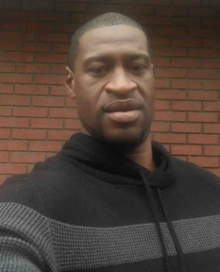George Perry Floyd Jr. (October 14, 1973 – May 25, 2020) was a black American man killed during an arrest in Minneapolis, Minnesota, after allegedly using counterfeit money to buy cigarettes. Derek Chauvin, a white police officer, knelt on his neck for nearly eight minutes as he lay handcuffed on the ground.[nb 1] After his death, protests against police violence toward black people quickly spread across the United States and internationally.
Floyd grew up in Houston, Texas. He played football and basketball throughout high school and college. He held several jobs, and he was also a hip hop artist and a mentor in his religious community. Between 1997 and 2005, he was convicted of eight crimes; in 2009, he accepted a plea bargain for a 2007 aggravated robbery, serving four years in prison.[2] In 2014, he moved to the Minneapolis area, finding work as a truck driver and a bouncer. In 2020, he lost his security job during the COVID-19 pandemic.
Early life and education
Floyd was born in Fayetteville, North Carolina to George Perry and Larcenia "Cissy" Jones Floyd.[3][4] He had four siblings.[5][6][7]
Floyd's parents separated and, when he was two, his mother moved with the children to the Cuney Homes public housing,[8][9][10] known as Bricks, in Houston's Third Ward, a historic black neighborhood and one of the poorest areas of the city.[3][4][8] Floyd was called Perry as a child, but also Big Floyd: being over six foot tall in middle school, he saw sports as a vehicle for improving his life.[8]
At Yates High School, Floyd played on the basketball team as a power forward, and as tight end on the football team helping lead them to the Texas state championships in 1992; he graduated in 1993.[3][8][9] He had made the varsity football team as a ninth grader; in tenth grade he was also co-captain of the basketball team.[6]
The first of his siblings to go to college, Floyd attended South Florida Community College for two years on a football scholarship, and also played on the basketball team.[8][11][12] He transferred to Texas A&M University–Kingsville in 1995, where he also played basketball before dropping out.[13] Friends and family called him Perry, and characterized him as a "gentle giant."[14][15] He was 6 feet 4 inches (193 cm) tall and weighed 223 pounds (101 kg).[16]
Later life
Floyd returned to Houston from college in Kingsville, Texas in 1995 and became an automotive customizer and played club basketball.[13][17] Beginning in 1994, he also performed as a rapper using the stage name "Big Floyd" in the hip hop group Screwed Up Click.[18][19][20][21]The New York Times described his deep-voiced rhymes as "purposeful", delivered in a slow-motion clip about "'choppin' blades' – driving cars with oversize rims – and his Third Ward pride".[8]
Between 1997 and 2005, Floyd was sentenced to jail terms eight times on various charges, including drug possession, theft and trespass.[2][8][6][nb 2] In 2009 he was sentenced to five years in prison for armed robbery[3][22][23] and was paroled in January 2013.[13]
After Floyd's release, he became more involved with Resurrection Houston, a Christian church and ministry, where he mentored young men.[3][8][24] He helped his mother recuperate after a stroke. He delivered meals and assisted on other projects with Angel By Nature Foundation, a charity founded by rapper Trae tha Truth.[25] Later he became involved with a ministry that brought men from the Third Ward to Minnesota in a church-work program with drug rehabilitation and job placement services.[8]
In 2014, Floyd moved to Minneapolis to find work.[26][27] He was a truck driver and a bouncer, and lived in St. Louis Park.[4][13][28] In 2017, he filmed an anti-gun violence video.[3][15] From 2017 to 2018 he was a security guard for a Salvation Army facility.[29] In 2019, George Floyd worked security at the El Nuevo Rodeo club with security guard Derek Chauvin.[30] In 2020, he lost his security job at a bar and restaurant affected by the COVID-19 pandemic rules.[31] That April, he contracted COVID-19, and recovered after a few weeks.[8][5]
Floyd had five children, including two daughters (ages 6 and 22) in Houston and an adult son in Bryan, Texas.[32][33][34] A former partner lives in Houston with his youngest daughter.[35] He also had two grandchildren.[5] A GoFundMe account to defray Floyd's funeral costs and benefit his family broke the site's record for number of individual donations.[36]
Death
On May 25, 2020, Floyd was arrested after allegedly passing a counterfeit $20 bill at a grocery store in the Powderhorn Park neighborhood of Minneapolis.[37] He died after Derek Chauvin, a white police officer, pressed his knee to Floyd's neck for nearly eight minutes[nb 1] during the arrest. Floyd was handcuffed face down in the street,[39][40][41] while two other officers further restrained Floyd and a fourth prevented onlookers from intervening.[42]:6:24[43][44] For the last three of those minutes Floyd was motionless and had no pulse,[39][41] but officers made no attempt to revive him.[45]:6:46 Chauvin kept his knee on Floyd's neck as arriving emergency medical technicians attempted to treat him.[45]:7:21
The official autopsy report classified Floyd's death as a homicide attributed to cardiopulmonary arrest caused by subdual and restraint.[16][46][47] A second autopsy, commissioned by Floyd's family and performed by Michael Baden, without access to various tissue and fluid samples, found that the "evidence is consistent with mechanical asphyxia as the cause" of death, with neck compression restricting blood flow to the brain, and back compression restricting breathing.[37] Some experts have theorized positional asphyxia.[48]
After Floyd's death, protests were held globally against the use of excessive force by police officers against black suspects and lack of police accountability. Protests began in Minneapolis the day after his death and developed in over 400 cities throughout all 50 U.S. states and internationally.[49][50]

Comments
Post a Comment